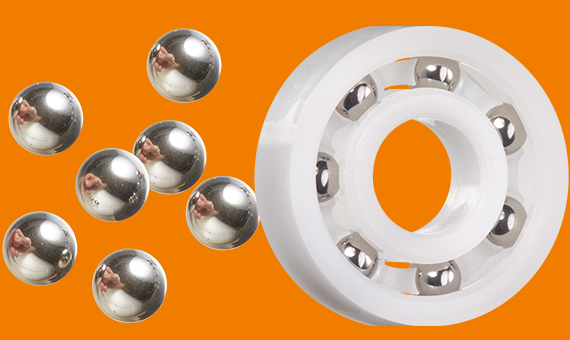What materials are used to make ball bearing balls?
Patrick Czaja | 26. March 2020
The material for rolling bearing ball bearing balls varies widely and is always primarily focused on the ring materials. This ensures that the interplay of cage, inner ring, and outer ring in the system is harmonised. This is especially important when the application involves heating or cooling the bearings. It is important that ball bearing running properties are always good. The most common ball materials are listed below with relation to the ring material.
Balls for metal ball bearings:
Roller bearing steel 1.3505/100Cr6
For these ball bearings, hardened steel balls are often used. The most often used material is a chrome steel with about 1% carbon and 1.5% chrome. The properties of steel balls of martensitic chrome steel make them especially well suited to ball bearing production, since they make stable components that are resistant and convincingly durable in continuous operation. Balls made of roller bearing steel are robust and durable. Susceptibility to corrosion tends to be low, so that cylindrical rollers and needle rollers are made of this material. But lubrication is indispensable.
Balls for plastic ball bearings
Stainless steel 1.4401 and 14401 (SS316L)
For ball bearings made of plastic, unhardened stainless balls are usually used. They are exceptionally corrosion-resistant and are also very resistant to saltwater and alkalis. Hardened balls need not be used for plastic ball bearings. The maximum permissible load is already limited by the limits of the material in the plastic rings. Stainless steel balls cost less than glass balls.

Soda-lime glass
Glass balls are used when a metal-free ball bearing is needed or the requirements for chemical resistance are high. Soda-lime glass is used for bottles, drinking glasses and flat glass, and as a material for ball bearing balls. It has good chemical properties suitable for ball bearings that are usually exposed to brief chemical stress, but not to great thermal stress. Its light green colour has also given it the name lemon glass.
Borosilicate glass
This type of glass is much more expensive than soda-lime glass. Borosilicate glass is even more chemical-resistant than soda-lime glass, which means that it is used in applications involving strong acids.
Other benefits:
- Very good resistance to heat and to changes in temperature
- Mechanical stability
- Low coefficient of linear expansion
This type is clear and transparent.
Balls for ceramic ball bearings:
Aluminium oxide Al2O3
Ceramic balls made of aluminium oxide, also known as oxide ceramics, have a polycrystalline structure. The properties of the lightweight balls include good corrosion, abrasion and heat resistance. Despite influences such as water, salt solutions and some acids, they are extremely resistant to corrosion. It is important to avoid contact with hydrofluoric acid, hydrochloric acid, warm sulphuric acid and strong alkaline solutions. They are also known to be self-lubricating and electrically insulating. Balls made of Al2O3 aluminium oxide are white to ivory-coloured and are manufactured according to ASTM F 2094 Class II/III.
Silicon nitride Si3N4
Balls made of the silicon nitride ceramic material are lightweight, but exhibit great toughness and outstanding resistance to corrosion. Only certain acids and base solutions cause corrosion. The material has an insulating effect. The balls are also self-lubricating and have great resistance to temperature fluctuations, which noticeably affects the bottom line. They are much more expensive than balls made of aluminium oxide. Balls made of Si3N4 are a black mother-of-pearl colour.

